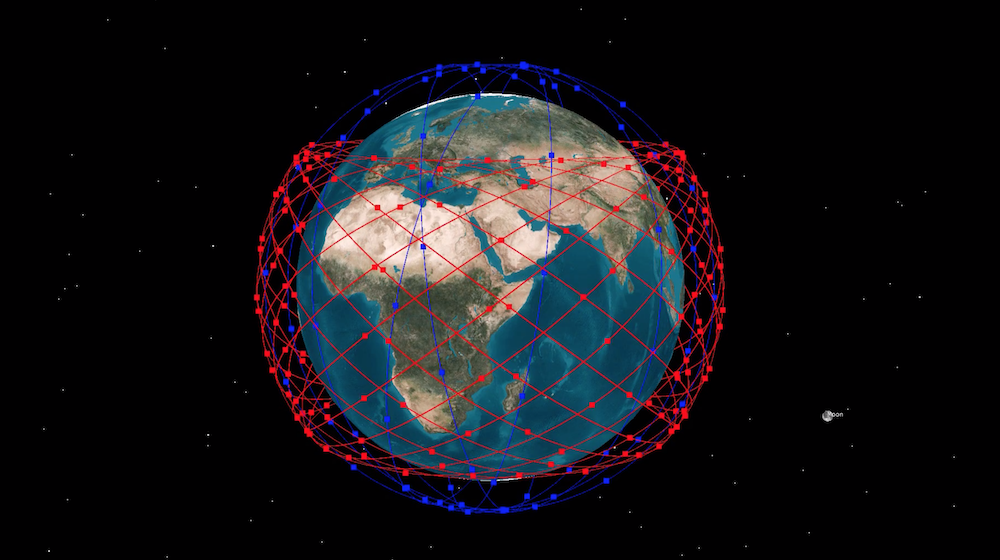Products You May Like
To compete in an unconventional program like the Space Development Agency’s Transport Layer, Lockheed Martin decided to team up with commercial companies.
WASHINGTON — A contract to build 10 satellites for the Pentagon’s Space Development Agency for $187.5 million is small for a company with $65 billion in annual sales. But Lockheed Martin sees it as a significant win, executives said, because it positions the company for a changing DoD space market that wants access to the latest commercial innovations.
Lockheed Martin and York Space Systems each will build 10 satellites for the Space Development Agency’s Transport Layer mesh network that will provide global high-speed broadband to military users.
Compared to traditional big-ticket satellite programs, the Transport Layer is a shift from the norm. It uses low-cost commoditized spacecraft to build a large constellation of interconnected satellites in low-Earth orbit.
Lockheed Martin CEO Jim Taiclet during a third-quarter earnings call with analysts last month called out the Space Development Agency contract as a “real breakthrough” that gives the company early entry into the Pentagon’s future space internet.
“This will be a competitive space,” said Taiclet, who is a former telecom executive. “And we want to get out in front of it.”
One of the key decisions that helped Lockheed Martin win the Transport Layer contract was to team up with commercial players, said Kay Sears, vice president and general manager of the military division of Lockheed Martin Space.
“Maybe it was a little bit of a surprise that we won,” Sears told SpaceNews in a recent interview.
“I think they picked us because of our approach … of working with other companies and bringing in nontraditional partners,” she said.
“We believe one of our responsibilities as a traditional defense contractor is to look broadly at the supply base and make sure we understand the technologies that other companies bring and onboard them onto programs,” Sears added. “That was a key part of a strategy with the Transport Layer, to have a strong group of companies to show key demonstrations.”
Lockheed Martin’s partners include Tyvak Nano-Satellite Systems — a company that Lockheed Martin directly invested in — and Telesat U.S. Services, a subsidiary of Canadian satellite operator Telesat, that plans to build a low-orbit broadband constellation of 298 satellites. A small business, Innoflight, provides the mission computer and payload processor.
Mesh network a ‘strategic’ capability
A key attribute of the Transport Layer is that data can be passed from satellite to satellite via optical links without having to rely on ground stations in areas where adversaries could jam signals or hack into systems. It was important for Lockheed Martin to be part of this program because of its strategic significance, Sears said, as the network will be used to connect military command centers, weapon systems and platforms across the sea, land, air and space domains, a concept known as joint all-domain command and control.
Transport Layer satellites — regardless of who makes them — have to be able to talk to each other via optical inter-satellite links that use lasers to beam data across space. The Space Development Agency said optical inter-satellite links are “one of the most critical technologies required to be demonstrated for Tranche 0.” Tranche 0 is the initial deployment planned for 2022.
The agency’s emphasis on interoperability and the use of optical inter-satellite links is why Lockheed Martin brought in Telesat. The commercial satellite operator was selected last month by the Defense Advanced Research Projects agency to deploy two satellites in 2021 to demonstrate optical inter-satellite links in orbit for DARPA’s Blackjack program.
Telesat is building a LEO constellation where each satellite will have four optical links. As Telesat begins to deploy the network starting in 2023, Lockheed Martin wants to demonstrate interoperability between the optical inter-satellite links of the Transport Layer satellites and those of Telesat’s LEO constellation.
Compatibility between the Transport Layer and commercial systems is not required under the Space Development Agency contract, but Lockheed Martin and Telesat want to make that happen. Their thinking is that the military will need bigger pipes to move data than what government satellites alone will be able to provide, so having access to commercial capacity will be important.
“Our idea to connect to a commercial LEO constellation would add resiliency and depth to the communications network,” Sears said.
The military now leases capacity on commercial geostationary satellites for communications and for moving data. Lockheed and Telesat want to show how military users of the Transport Layer could move traffic over LEO commercial networks.
Government-commercial interoperability will require everyone to agree on standards for optical inter-satellite links so they can connect.
Telesat’s satellites for the DARPA demonstration will use laser communications terminals made by the German company Mynaric. As part of the deal, Mynaric will build a laser communication interoperability lab in Los Angeles that will simulate conditions in space to test interoperability between different vendors’ terminals.
The optical links for the Transport Layer satellites will be tested at the Naval Research Laboratory in Washington, D.C. The lab will have to certify that the laser communications terminals in Lockheed Martin’s satellites are interoperable with those used by the other vendor, York Space Systems.
Lockheed Martin said Telesat’s supplier Mynaric is not providing the optical links for the Transport Layer. A spokesman said Lockheed could not yet disclose which vendor it has selected.
